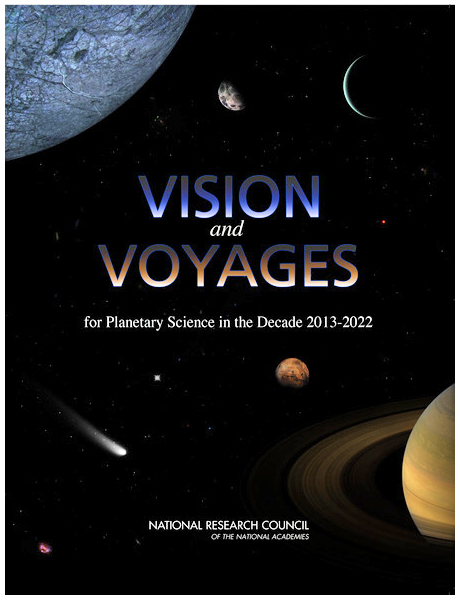Progress Made Toward Planetary Science Decadal Priorities

Richard Fienberg Running Hare Observatory
This post is adapted from a National Academies press release:
Despite significant cuts to NASA's Planetary Science Division budget early in this decade, the space agency has made impressive progress in meeting goals outlined in the 2013-2022 planetary decadal survey by the National Academies of Sciences, Engineering, and Medicine, says a new midterm assessment from the National Academies. The report notes that the agency met or exceeded the decadal survey's recommendations for funding research and analysis, and for technology programs. However, NASA has not achieved the recommended timeline for New Frontiers and Discovery missions for the decade. At least one more New Frontiers mission and three Discovery missions should be selected before the end of the decade in order to achieve the schedule recommended in Vision and Voyages.
 The decadal survey, Vision and Voyages for Planetary Science in the Decade 2013-2022, recommended a suite of planetary science flagship missions that could provide a steady stream of important new discoveries about the solar system as well as prospective mid-size missions and science, research, and technology priorities. It also included a set of decision rules on how to deal with funding shortfalls as well as possible increases. The new report assesses progress made by NASA so far and offers recommendations for preparing for the next decadal survey.
The decadal survey, Vision and Voyages for Planetary Science in the Decade 2013-2022, recommended a suite of planetary science flagship missions that could provide a steady stream of important new discoveries about the solar system as well as prospective mid-size missions and science, research, and technology priorities. It also included a set of decision rules on how to deal with funding shortfalls as well as possible increases. The new report assesses progress made by NASA so far and offers recommendations for preparing for the next decadal survey.
"Since the publication of Vision and Voyages, planetary science has made many advances, including acquiring results from several highly successful missions," said Louise Prockter, director of the Lunar and Planetary Institute in Houston, Texas, and co-chair of the committee that conducted the study and wrote the report. "This decadal survey has served the planetary science community well, justifying a plan for planetary science that has been successful in supporting research and obtaining steady funding for missions."
NASA has begun development of two of the decadal survey's top recommended flagship missions, the Europa Clipper, an interplanetary mission that will place a spacecraft in orbit around Jupiter in order to perform a detailed investigation of the moon Europa, and the Mars 2020 rover, which will collect samples for eventual return to Earth. However, the committee noted its concern about the aging infrastructure orbiting Mars, which is vital for communicating with the rovers on the surface. The loss of one or more of these spacecraft could make it difficult for NASA to support the return of samples from the surface of Mars.
"NASA has made a strong investment in technology that has exceeded the Vision and Voyages recommended levels," said committee co-chair Joe Rothenberg, former NASA associate administrator for space flight, Goddard Center director, and co-chair of the committee that conducted the new study and wrote the report. "This investment has not only enabled science missions in this decade, but is providing for the long-term technology development needed for missions in the next decade, including the Mars sample return program and the exploration of planetary bodies with extreme environments."
The committee developed recommendations for the remainder of the decade based on categories including large strategic missions, NASA's Mars exploration program, telescopes and planetary science, and education and public outreach. Among the recommendations:
- Continue to closely monitor the cost and schedule associated with the Europa Clipper to ensure that it remains executable within the approved life-cycle cost range.
- Continue planning and begin implementation of NASA's proposed "focused and rapid" architecture for returning samples from the Mars 2020 mission so as to achieve the highest priority decadal flagship-level science.
- Reevaluate the Mars Exploration Program, which currently has only the Mars 2020 rover in its future missions queue.
- Continue investment in development of mission-enabling technologies at 6% to 8% of the Planetary Science Division's budget.
- Link education and outreach activities directly to the missions that are providing the science content for those programs, working directly with mission scientists and engineers to ensure a strong connection to NASA's mission results.
In preparation for the next decadal survey, the report recommends that NASA sponsor eight to ten mission concept studies that include options described in the Academies report, Getting Ready for the Next Planetary Decadal Survey. Concept studies have value for the next decadal survey, enabling science objectives to be defined, the overall mission scope to be determined, and the community to begin preparing for the next decadal survey.
The midterm study was funded by NASA. The National Academies of Sciences, Engineering, and Medicine are private, nonprofit institutions that provide independent, objective analysis and advice to the nation to solve complex problems and inform public policy decisions related to science, technology, and medicine. The National Academies operate under an 1863 congressional charter to the National Academy of Sciences, signed by President Lincoln.

